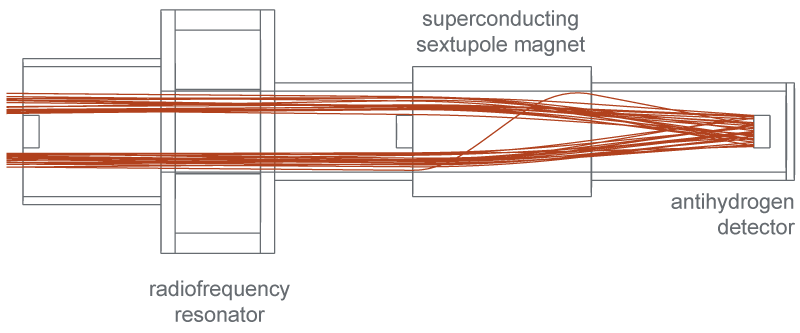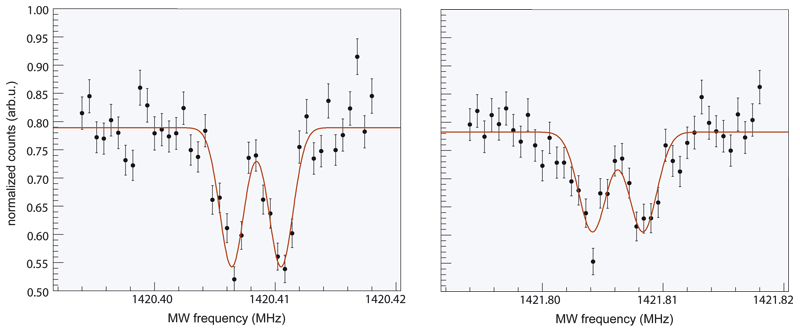Phase 1: HFS measurements with a single cavity
Apart from the existing cusp trap, the atomic beam line and an antihydrogen detector are needed. For the atomic beam line, the group at SMI has developed and built a microwave cavity for 1.4 GHz and purchased a sextupole magnet, which arrived in early 2011. In 2011, a detector (a position-sensitive MCP surrounded by scintillators as veto for cosmic rays) was provided by the group of Prof. Y. Yamazaki of RIKEN (Japan). Thus all components for a measurement depicted in Fig. 2 were available, successfully tested and installed in the ASACUSA area for the beam time in 2011 (see Fig. 3).
The experiment will be performed using the same principle methods as previous ones on hydrogen, but adopted to the experimental conditions of antihydrogen. A major difference is the scarcity of antihydrogen atoms, leading to the necessity of designing atomic beam lines with much larger transmission than used before. This requires cavities and sextupole magnets with apertures of 10 cm, which have already been constructed.
In order to avoid a field-free region inside the cavity, where atoms might be lost by Majorana spin-flips, a small (strength a few Gauss) but homogeneous magnetic field will be applied. Fig. 4 shows the behaviour of HFS states in an external magnetic field and the possible transitions involving a flip of the positron spin to transfer low-field seekers (F,M)=(1,-1) and (1,0) into high-field seekers (1,1) and (0,0).
The shielding of the external fields of cusp trap and sextupole and the application of a homogeneous static magnetic field over an area of 10 cm diameter is not trivial. A preliminary shielding has been designed and built in 2011 providing sufficient homogeneity (1%) for the measurement of the σ1 transition. A source producing a slow beam of polarized mono-atomic hydrogen will be developed as a part of this proposal to test the performance of cavity and sextupole.
Monte-Carlo simulations have been performed [12] to determine the possible signal rate and resolution, based on simulations of the antihydrogen beam parameters from Prof. Yamazaki’s group (cf. Fig. 5 and 6). Since the π1 transition is very sensitive to the magnetic field inhomogeneity, in a first step only σ1 can be measured at different magnetic field strength and the HFS frequency be determined by extrapolation to zero field, giving a first value on the HFS of antihydrogen at reduced precision of 10–6. In a second step the more time consuming measurement of the π1 transition can then be performed. For the measurement of the π1 transition, which is more sensitive to the magnetic field, a new shielding has to be designed. Simulations show that with a realistic setup including imperfect homogeneity of the static magnetic field, a relative accuracy of about 10–7 can be achieved, provided both σ1 and π1 transitions can be measured in the same magnetic field.
Since the setup has a small transmission, event rates of less than one per second are expected at the antihydrogen counter, which are feasible since antiproton annihilation can be distinguished from cosmic rays by the large energy deposited. Further studies are needed to optimize the antihydrogen detector as to achieve the highest possible detection efficiency and background suppression.
Fig. 3: Atomic beam line set up at CERN-AD in 2011. The cavity can be seen to the left, the sextuopole in the center.
Fig. 4: Breit-Rabi diagram for antihydrogen showing the behaviour of HFS states in an external magnetic field. F is the total spin and M the magnetic quantum number.
Fig. 5: Simulated trajectories through the microwave cavity and sextupole.
Fig. 6: Monte-Carlo simulations of the σ1 (left) and π1 (right) transitions in a constant magnetic field of 1 Gauss with homogeneity of 10–3. The double peak structure appears due to the Doppler splitting of the antihydrogen atoms traversing the longitudinal standing wave in the microwave cavity. Assuming a production of 105 antihydrogen atoms per cycle of the AD (100 seconds) each spectrum would take about one week to record.




